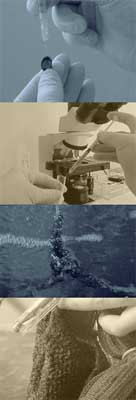Aquiculture
Biotechnology
 With financing of a Fondef Project,
a team of researchers from the
department of Oceanography is
working on the optimization of
the cultivation technology for the
mussel Choromitylus chorus in
its diverse stages to promote the
development of its industrial
activity and strengthen its
exportation potential. With financing of a Fondef Project,
a team of researchers from the
department of Oceanography is
working on the optimization of
the cultivation technology for the
mussel Choromitylus chorus in
its diverse stages to promote the
development of its industrial
activity and strengthen its
exportation potential.
An important part of this initiative– that is based in the University’s
hatchery in the Marine Biology
Station in Dichato – is oriented
at solving, using biotechnological
techniques, a problem that has
reduced the viability of this
resource’s foreign
commercialization: the female’s
gonads brownish-black color
produces disgust in the
consumer. To solve this problem,
the researchers are striving to
increase the percentage of the
male exemplars in cultivation
and/or lighten the color of the
female gonads.
Three alternatives have been
planted to solve this problem:
selective crossing with lighter
individuals, hormone treatment
to induce a sex change, and
chromosome manipulation. The first line of research was oriented
towards researching different
populations throughout the
country to identify lighter-colored
individuals. These individuals
would then be used to obtain
through successive crossings over
several generations, lightercolored
organisms. Population
analysis, however, found little
difference in tonalities, and this
area of intervention was
abandoned.
Hormonal treatment
Animal and vegetal substances,
such as the hormones contained
in the masculine mussel gonads,
have been tested to induce the
formation of males. The hormonal
treatment is applied during the
first development stages, before
sexual differentiation, at a size
between 2 and 2.5 centimeters.
In the first tests, the direct
injection of substances was
rejected for being highly invasive
and the use of vegetal products
was rejected for its toxicity. The
best results have been obtained
with animal and the mussel’s own
hormones, which are
administered through periodic
bathes. The greatest difficulty in
the case of their own hormones
lies in the large number of adults
that need to be squeezed to
extract the hormones. Tests with
androgenic substances, which are
used in humans, have also been
performed, to increase the
masculine expression.
Triploid and neo-male
organisms
In the area of genetic
manipulation, two paths have
been defined that are based on
a detailed knowledge of the
species’ chromosome
characteristics: the use of triploid
individuals (with three sets of
chromosomes) and the
generation of neo-males through
gynogenesis.
The triploid produces, between
98 and 99%, asexual beings with
stunted gonad development,
concentrating most of their
energy in tissue production, which
implies greater growth rates and, in the case of this mussel, the
disappearance of the brown color
from the female gonads.
The triploid intervention takes
places at the moment of
fecundation. In the natural
process of the bivalves, the
masculine gamete arrives with a
chromosome set, while the ovum
comes with two. When the sperm
enters the ovum, it liberates two
polar corpuscles, forming a
haploid cell that fuses with the
male gamete’s nucleus,
generating a diploid individual.
With the use of chemical
substances, which have been
successfully applied in oysters
and scallops, the expulsion of the
second polar corpuscle is avoided.
In this way, the organisms remain
with three sets of chromosomes,
two supplied by the female and
one by the male.
The second alternative in
chromosomal management
consists in the generation of
gynogenetic organisms, where
only the maternal DNA
intervenes. The technique
consists in eliminating the genetic
material of the masculine
gametes by ultraviolet radiation
treatment. Without their DNA,
the sperm, when united with the
ovule, only fulfills the inductor
function of cellular division, where
diploid restitution is necessary to
avoid the expulsion of the second
polar corpuscle. As a result, diploid individuals of feminine
character are generated, which
are subsequently submitted to
hormone treatments for their
masculinization.
The definitive results of these
experiments will be confirmed
when the individuals reach the
size of 5 centimeters. |

